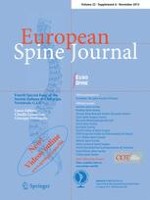01-11-2013 | Original Article
Preoperative calculation of the necessary correction in sagittal imbalance surgery: validation of three predictive methods
Published in: European Spine Journal | Special Issue 6/2013
Login to get accessAbstract
Introduction
Surgery for correction of sagittal imbalance has frequent adverse events and complications. The most frequent cause of failure is inadequate correction of imbalance. The aim of this study is to verify the accuracy of three published methods (exact method by Ondra, FBI method by Le Huec and spinofemoral angle method by Lamartina) to preoperatively calculate the needed correction.
Design
This is a retrospective cohort study.
Methods
Fifteen patients treated for correction of sagittal imbalance, with preoperative and postoperative lateral standing whole spine radiographs, were identified. Preoperative calculation of the amount of needed correction has been done using these methods. In postoperative X-rays, the amount of correction obtained with and the degree of correction of sagittal imbalance have been measured.
Results and discussion
The FBI and SFA methods obtain equivalent calculations of the amount of needed correction. The estimated correction angle with both methods is higher than that calculated with the exact trigonometric method. The difference between the latter and the former methods is equivalent to the observed excess of pelvic tilt.





